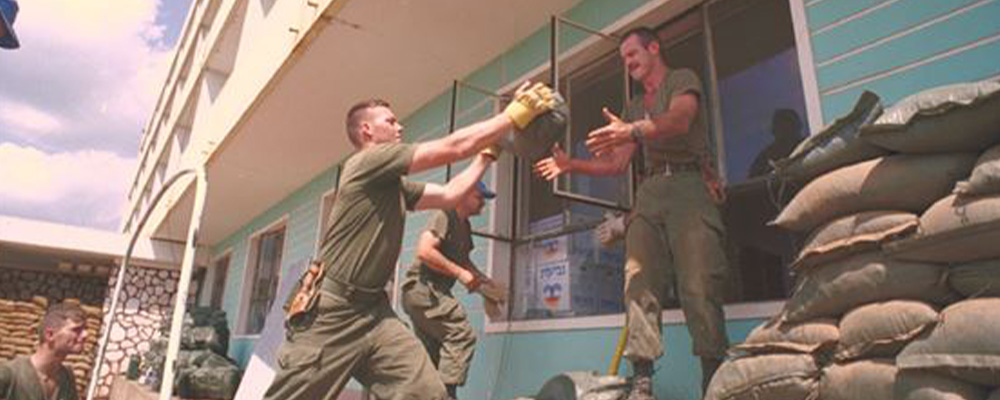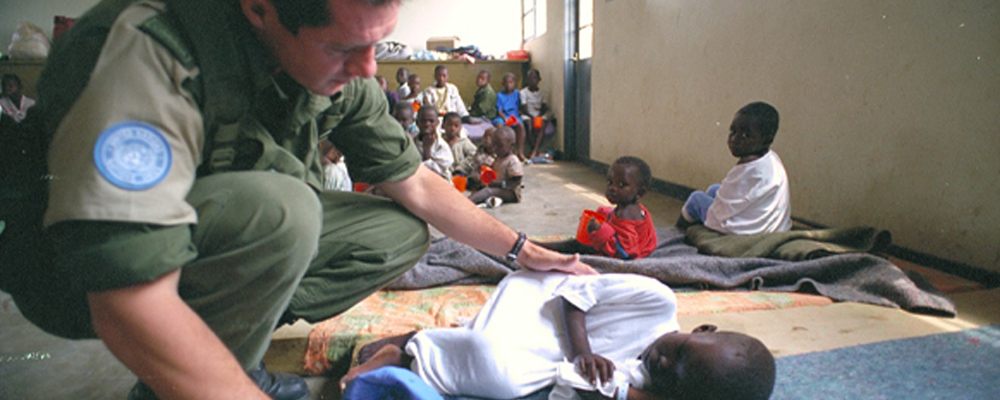Order of events
October 1990 - August 1993
Renewed civil warfare in Rwanda displaces hundreds of thousands of people
4 August 1993
Rwandan government and Rwandan Patriotic Front sign the Arusha Peace Agreement
5 October 1993
United Nations (UN) creates the United Nationals Assistance Mission for Rwanda. Canada's Major-General Roméo Dallaire is its commander
6 April 1994
Rwandan President Juvénal Habyarimana is assassinated
7 April 1994
Hutu extremists launch a genocide against the Tutsis and moderate Hutus. During the next 100 days, an estimated 800,000 Rwandans died.
May 1994
UN launches renewed peacekeeping effort, called the United Nations Assistance Mission for Rwanda II (UNAMIR II). Its mission is to try to protect civilians and provide humanitarian aid
July 1994
Worst of genocide ends. New government established in Rwanda, though violence persists
Late July 1994
First large contingent of Canadian Armed Forces (CAF) members deployed to Rwanda for UNAMIR II
August 1994
Canada's Major-General Guy Tousignant assumes UNAMIR II command
15 February 1996
Last UNAMIR II Canadian peacekeepers leave Rwanda
Classroom materials
Canada played an important role in United Nations (UN) peacekeeping missions in the African nation of Rwanda from 1993 to 1996. Juvénal Habyarimana, the Hutu president of Rwanda, was assassinated on 6 April 1994. Hutu extremists retaliated with a nightmare of violence. Over the next 100 days, more than 800,000 Tutsis and moderate Hutus died. This was one of the worst genocides of the 20th century. UN peacekeepers were unable to stop the worst of the violence. Canadian Armed Forces (CAF) members tried to restore order. They delivered needed humanitarian aid and other help. Hundreds of CAF members returned from Rwanda affected by the horrors they had seen.

Background to the conflict
(Pre-1993)
Violence between Rwanda's governing Hutus and the Rwandan Patriotic Front headed toward a full-scale civil war.
Rwanda
Rwanda is a small, densely-populated rural nation in central Africa. It covers about 26,000 square kilometres, about half the size of Nova Scotia, Canada. In the early 1990s, Rwanda’s population was approximately eight million people.
Hutus and Tutsis
The Hutu and Tutsi tribes form the majority of the country’s population. The minority Tutsis dominated Rwanda's economy and politics for centuries. In 1960, the Hutus rose up and forced hundreds of thousands of Tutsis to flee the country. Rwanda became independent in 1961 but the unrest continued. Some of the Tutsis who had fled the country formed rebel groups and tried to make an armed comeback in Rwanda. This led to decades of ethnic violence and tensions.
Rwandan Patriotic Front
In the late 1980s, the Rwandan Patriotic Front was formed. Its members were Tutsis and moderate Hutus who fled the country. They soon began attacks on Rwanda to challenge its Hutu government. These new rounds of violence displaced hundreds of thousands more Rwandans. The situation headed toward a full-scale civil war.

Attempts to find peace
(June 1993 – April 1994)
The Rwandan government and the Rwandan Patriotic Front signed the Arusha Peace Agreement.
On 22 June 1993, the United Nations Observer Mission Uganda-Rwanda was formed. Its goal was to ensure no outside military aid reached Rwanda to prevent further violence. Canada’s Major-General Roméo Dallaire was its Chief Military Observer. The CAF codenamed Canada’s involvement in this mission Operation LANCE.
Arusha Accords
On 4 August 1993, the Rwandan government and the Rwandan Patriotic Front signed the Arusha Peace Agreement. The purpose was to create a transitional government and national assembly. Tensions continued to build although both parties signed the agreement.
United Nations Assistance Mission for Rwanda
On 5 October 1993, the UN formed the United Nations Assistance Mission for Rwanda (UNAMIR). Its purpose was to help enforce the Arusha Peace Agreement. The CAF continued Operation LANCE and soon named Major-General Dallaire as its commander. Even with this new UN mission in place, the bad situation in Rwanda was about to turn into a nightmare.

Genocide
(1994 – July 1994)
President Habyarimana’s assassination led Rwanda into 100 days of horrific violence. More than 800,000 Rwandans died.
Presidential assassination and retaliation
On 6 April 1994, a plane carrying the Hutu president of Rwanda, Juvénal Habyarimana, and the president of Burundi, Cyprien Ntaryamira, was shot down. This assassination led to an explosion of violence. Hutu extremists launched a genocide against the Tutsis and moderate Hutus. During the next 100 days, an estimated 800,000 Rwandans died.
Rwandan Patriotic Front strikes back
The Rwandan Patriotic Front, led by future Rwandan president, Paul Kagame, launched a major offensive on April 8. Its goal was to end the genocide and rescue its troops in parts of Rwanda. These efforts took time, however, and the widespread killing continued for three months.
A compromised mandate
The duties of Canadian and other UN peacekeepers in Rwanda were extremely challenging. At first, Canada had only two senior officers—Major-General Dallaire and his principal aid Major Brent Beardsley. Once the genocide began, more CAF members became involved.
The limitations they had to work under made the situation even harder. The UN troops’ rules of engagement for UNAMIR were very restricted. Peacekeepers were only allowed to attempt the peaceful resolutions of disputes. This meant soldiers could only fire their weapons in self-defence. As a result, UN forces could not prevent the worst of the horrific violence as the genocide raged around them.
Operation SCOTCH
On April 9, the CAF launched Operation SCOTCH. Its initial mission was to use transport planes to evacuate Canadian, Belgian and other foreigners trapped in Rwanda. They also flew orphans to safety and delivered humanitarian aid to the country.
Canada’s Airlift Control Element personnel supported other UNAMIR operations, as well. Canada began evacuating many foreign peacekeepers when the UN decided the situation in Rwanda was too chaotic to remain. The air mission was extended as UNAMIR continued to need its services. CAF planes defied the dangerous fighting. They brought in needed food, fuel, water and humanitarian supplies. This ongoing link to the outside world was a key symbol of hope in a country that had descended into chaos. By the time Operation SCOTCH wrapped up in October 1994, around 350 CAF members had taken part in it.
The world watches the horror
Media reports from Rwanda in April 1994 allowed the world to see the horrific situation. Television images showed the thousands of dead and countless refugees fleeing the country. The limits of what the UNAMIR peacekeepers could do were frustrating. The UN decision to withdraw many peacekeepers also reduced how they could help. Meanwhile, UN efforts to negotiate an end to the violence failed.
The genocide ends
On 23 May 1994, the Rwandan Patriotic Front took control of the presidential palace in Kigali. By July, the worst of the killing finally came to an end. A ceasefire began and the Rwandan Patriotic Front established a new government in Rwanda. The situation in the country remained uneasy, as violence continued. The deaths of hundreds of thousands of its citizens and the suffering of many refugees left Rwanda in great need of help.

Canada and the world responds
(July 1994 – March 1996)
The United Nations Assistance Mission for Rwanda II is created to stop massacres, protect civilians and provide humanitarian aid.
Humanitarian efforts
The UN struggled to stop the genocide. So, it changed its operations in Rwanda in May 1994. The United Nations Security Council created an expanded mission, commonly known as the United Nations Assistance Mission for Rwanda II (UNAMIR II). Its aim was to stop the massacres, protect civilians and provide humanitarian aid. Major-General Dallaire would command UNAMIR II’s 5,500 multinational troops.
More Canadian peacekeepers arrive
Several hundred more CAF members began deploying to Kigali in mid-July 1994. Their duties would vary. The first to come had to set up a barracks and help reestablish the UN mission headquarters there. The main task of the initial Canadian UNAMIR II contingent was to create a reliable communication system in the war-torn country. It would not be easy for our peacekeepers.
A perilous mission
The Canadians were some of the first peacekeepers to arrive for UNAMIR II. Some other country’s troops would not arrive until much later. Our soldiers’ duties often meant they had to deploy in small groups to isolated areas. They saw the horrific after-effects of the genocide, with countless bodies everywhere. The strict rules of engagement still limited the Canadian soldiers from getting involved when they saw new violence. Sometimes they would also encounter armed gangs and have to diffuse the standoff.
Helping in many ways
A later Canadian contingent came to offer logistical support to the UN force. These troops provided vital vehicle transport, maintenance and supply capabilities. Through it all, Canadians tried to help the local people. Our soldiers often shared their rations with hungry children. They got humanitarian aid like food and medicine to the suffering Rwandan people. They risked their lives to transport people from danger zones to safer places. They also took on more personal support projects, such as helping set up local orphanages and visiting the small children living there.
Operation PASSAGE
The CAF also launched Operation PASSAGE in the summer of 1994 to provide medical services to refugees returning to Rwanda. In August, the Canadians built a field hospital with doctors, nurses, medics and other support personnel. The Canadians often picked up people in need at roadside collection points and took them to the field hospital for treatment.
Canadian military engineers worked on local water supplies to improve the health of Rwandans. They also helped clear landmines and unexploded bombs. Our peacekeepers taught local people about these dangerous weapons still scattered across the country.
A change in command
In August 1994, Canada’s Major-General Guy Tousignant became the new UNAMIR II Force Commander. He built on Major-General Dallaire's great example of leadership in difficult circumstances. Major-General Dallaire returned to Canada.
Canadians return home
Canadian peacekeepers rotated in and out of Rwanda as the UN mission continued and its needs evolved. In early 1995, CAF members began returning home. By February 1996, the last Canadian peacekeepers who had been supporting UNAMIR II finally left.

Sacrifice
When people think of peacekeeping, they may not realize, in some circumstances, how little “peace” there often is to “keep”. The risk of harm is very real. About 130 CAF members have died in the course of international peacekeeping efforts. One soldier lost his life in Rwanda. The effects of serving in these missions can be psychological as well as physical. Seeing the widespread death and suffering in Rwanda took a great toll on a number of our Veterans. Some of our peacekeepers who served there went on to suffer from post-traumatic stress disorder.
Legacy
Post-1996
Canadian Armed Forces members leave Rwanda. Despite Canadians’ efforts being restricted during the genocide, they saved many Rwandans.
Controversy surrounded the mission and hundreds of thousands of people died. But the UN efforts in Rwanda made a difference. Even though Canadians’ efforts were restricted during the genocide, they rescued many Rwandans. Canadian peacekeepers assisted countless Rwandans in the aftermath of the killing. They provided help through communications, logistical, medical and mine clearing efforts.
In the words of Major-General Dallaire, these CAF contributions to the people of Rwanda were “...nothing less than a godsend.” Our country recognized the great efforts of the Canadian generals who commanded the UN peacekeeping missions in Rwanda. Major-General Dallaire and Major General Tousignant both earned the Meritorious Service Cross for their leadership in the face of some of the worst conditions imaginable.
Rwanda today
Rwanda still continues to recover from its violent past. The country has seen much economic growth, and today it is much more peaceful. Rwanda has two public holidays to mark the 1994 mass killings, and denial of the genocide is a criminal offence.
The Rwandan crisis helped spur the creation of the International Criminal Court. It investigates claims of genocide, crimes against humanity and war crimes—like those that the world saw so clearly in Rwanda in the 1990s.
- Date modified:






